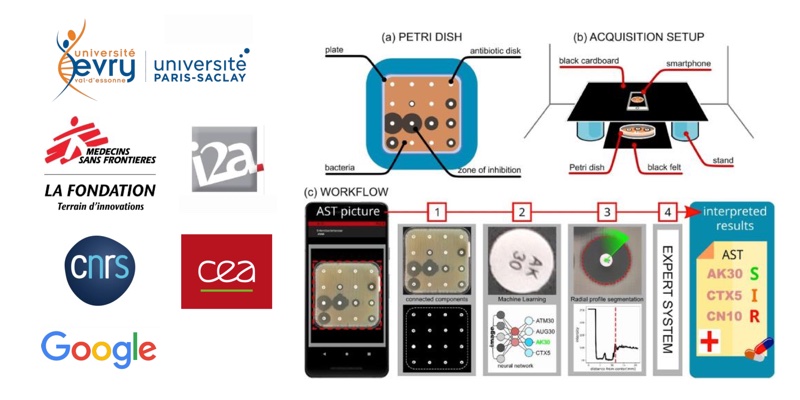In an article published in the journal Nature Communications on February 19, 2021, researchers from the University of Évry, CEA, CNRS, APHP, CHU Henri Mondor and Médecins Sans Frontières (MSF) unveiled the mobile application developed to facilitate the diagnosis of antibiotic resistance, a major public health issue. The results demonstrating the technical feasibility of such an application are presented in the article.
This tool, created with the support of the MSF Foundation, will be freely usable worldwide by health workers after its clinical validation and CE certification, which is currently being finalised by MSF teams.
Antibiotic resistance is a major threat to global health.
The World Health Organization (WHO) points to the increasing resistance of microorganisms to antibiotics as one of the major health challenges of the 21st century. Antimicrobial resistance could become the world's leading cause of death from cancer, causing 10 million deaths a year, nearly 90% of them in Asia and Africa, due to lack of resources. The reasoned use of antibiotics is therefore essential and requires a robust assessment of the sensitivity of bacteria to antibiotics. MSF has been involved in the fight against antibiotic resistance for several years, mainly in countries in conflict where MSF receives war wounded infected with multi-resistant bacteria.In industrialized countries, the identification of antibiotic resistance is facilitated by the use of automated systems for reading and interpreting antibiotic susceptibility tests. Microbiologists culture the bacteria of the patient to be treated in Petri dishes on agar medium. They place paper discs containing a precise concentration of each antibiotic. These discs diffuse into the agar and may or may not kill the bacteria present. When the bacteria are sensitive to the antibiotic, they disappear in a concentric zone around the disc: this is called the inhibition zone. Antibiotic resistance is defined by measuring the diameter of these inhibition zones and comparing them to reading charts. The interpretation depends on precise rules proposed by experts in microbiology.
These antibiotic susceptibility tests are performed by technicians and then generally analyzed in expensive antibiotic incubator readers. In this way, medical microbiology laboratories can offer a result to the clinician so that he or she can choose the appropriate molecules, which are both effective in treating the patient and avoid the development of resistant bacteria.
In developing countries, the identification of antibiotic resistance is much more difficult as MSF has been experimenting with when setting up bacteriology laboratories in five resource-limited countries.
Based on this observation, drawn up by Nada Malou, MSF Microbiology referent after several years in the field, Amin Madoui, a CEA researcher at the Genoscope Metabolic Genomics Laboratory (CEA/CNRS/University of Evry, Genopole® site), proposed a mobile application solution:
"We needed to create a free, easy-to-use application and develop new algorithms to efficiently process the image of an antibiotic susceptibility test on a smartphone.The MSF Foundation saw this project as an opportunity to create an innovative technological solution to a real-life problem and in 2018 initiated this collaborative project between a team of scientists from the Genoscope Metabolic Genomics Laboratory (CEA/CNRS/University of Evry), the Mathematics and Modeling Laboratory of Evry (CNRS/University of Evry, Genopole® site), the Bacteriology Department of the Henri Mondor Hospital (APHP, Créteil) and MSF with the aim of developing this open source tool, intended for healthcare professionals worldwide, capable of analyzing and interpreting antibiotic susceptibility tests.
In 2019, the project won a grant in the Google AI Impact Challenge competition, on Artificial Intelligence (AI) with high societal impact. It provides human resources and allows deep learning tests to improve the performance of the application in terms of handwriting recognition (the algorithm recognizes all the names of antibiotics).
The application created works without an internet connection, which is essential for use in low-resource countries. It takes pictures of the antibiogram with the phone's camera, and guides the user through the analysis. It can interact at any time with the application's interface to check and possibly correct the automatic measurements if necessary.
To do so, it combines original algorithms, using machine learning and image processing. A high-performance expert system provided by i2a validates the consistency of the data and provides interpreted results. The measurement procedure is fully automatic and reaches a very high level of reliability with 98% agreement with the most reliable manual measurement today.
Today the mobile application has the ambition to adapt to the resource-constrained environments where MSF works. It would provide quality antibiotic susceptibility testing for all patients worldwide and could contribute to the global effort to monitor antibiotic resistance.
In 2021, MSF is currently evaluating the clinical performance of this application in 3 different countries with the aim of deploying it in its laboratories by the end of 2021. The application will then be made available to all laboratories in resource-constrained countries by 2022.
With only a few months to go before the end of the assessments and the beginning of the deployment phase, MSF calls on all partners involved in the fight against antibiotic resistance to collaborate in order to make this application available to as many laboratories as possible in resource-limited countries.
Translated from Des chercheurs dévoilent une application de diagnostic de la résistance aux antibiotiques grâce à l’intelligence artificielle


